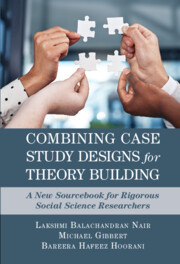 Combining Case Study Designs for Theory Building
Combining Case Study Designs for Theory Building Book contents
- Combining Case Study Designs for Theory Building
- Combining Case Study Designs for Theory Building
- Copyright page
- Contents
- Chapter 1 Introduction to Case Study Research
- Chapter 2 Building Blocks of Case Study Research
- Chapter 3 Of Talking Pigs and Black Swans
- Chapter 4 Do It Again
- Chapter 5 The Natural Experiment, a.k.a. the Single Embedded Design
- Chapter 6 Do It Again (and Again)
- Chapter 7 Sequencing Case Study Designs
- Chapter 8 More on Sequencing Case Study Designs
- Chapter 9 A Parting Note, on an Optimistic Note
- Index
- References
Chapter 4 - Do It Again
The Evidentiary Basis of Case Studies Is Plural
Published online by Cambridge University Press: 02 February 2023
- Combining Case Study Designs for Theory Building
- Combining Case Study Designs for Theory Building
- Copyright page
- Contents
- Chapter 1 Introduction to Case Study Research
- Chapter 2 Building Blocks of Case Study Research
- Chapter 3 Of Talking Pigs and Black Swans
- Chapter 4 Do It Again
- Chapter 5 The Natural Experiment, a.k.a. the Single Embedded Design
- Chapter 6 Do It Again (and Again)
- Chapter 7 Sequencing Case Study Designs
- Chapter 8 More on Sequencing Case Study Designs
- Chapter 9 A Parting Note, on an Optimistic Note
- Index
- References
Summary
We discuss multiple case studies in this chapter. We start off with a discussion of theoretical sampling and replication logic. We specifically discuss literal and theoretical replication (LR and TR) in connection with multiple case studies. The strengths and limitations of LR and TR are discussed thereafter. In particular, we deliberate upon the potential of TR to enhance the internal and external validity of a case study. Henceforth, we address some common (mis)conceptions regarding replication logic, internal validity, external validity (generalizability), and reliability. We also discuss how multiple case studies might need to sacrifice the depth of observation for breadth. Other potential weaknesses, such as the smaller number of independent variables and the difficulty in controlling context, are also discussed thereafter.
Keywords
- Type
- Chapter
- Information
- Combining Case Study Designs for Theory BuildingA New Sourcebook for Rigorous Social Science Researchers, pp. 50 - 77Publisher: Cambridge University PressPrint publication year: 2023


